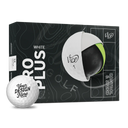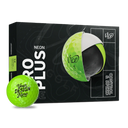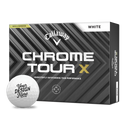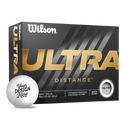Free Shipping on Orders $149+
Find The Right Golf Ball
This is your complete guide to finding the right ball for your game. We've broken down the real specs that matter: compression ratings, spin characteristics, and construction details across every brand we carry.
| Ball | Skill Level | Price | Layers | Compression | Cover | Spin | Off the Club | Dimples | Swing Speed |
|---|---|---|---|---|---|---|---|---|---|
| Bridgestone Tour B X | Advanced | $$$ | 3-piece | 94 | Urethane | Long-Low / Short-High | Firm | 330 | 105+ mph |
| Bridgestone Tour B XS | Advanced | $$$ | 3-piece | 84 | Urethane | Long-Mid / Short-Higher | Mid | 330 | 105+ mph |
| Bridgestone E12 Straight | Recreational | $$ | 3-piece | 65 | Ionomer | Long-Low / Short-Mid | Mid | 322 | Under 95 mph |
| Bridgestone e6 Soft | Beginner | $$ | 2-piece | 50 | Ionomer | Low | Soft | 330 | Under 90 mph |
| Bridgestone Treo | Recreational | $ | 2-piece | 80 | Hybrid | Low | Soft | 330 | Under 90 mph |
| Callaway Chrome Tour | Advanced | $$$ | 4-piece | 88 | Urethane | Long-Low / Short-High | Mid | 332 | 105+ mph |
| Callaway Chrome Tour X | Advanced | $$$ | 4-piece | 98 | Urethane | Long-Mid / Short-Higher | Firm | 332 | 105+ mph |
| Callaway Chrome Soft | Intermediate | $$$ | 3-piece | 72 | Urethane | Long-Low / Short-High | Soft | 332 | 90+ mph |
| Callaway Supersoft | Beginner | $$ | 2-piece | 45 | Hybrid | Low | Soft | 332 | Under 90 mph |
| Callaway ERC Soft | Recreational | $$$ | 3-piece | 60 | Hybrid | Long-Low / Short-Mid | Soft | 332 | Under 95 mph |
| Callaway Warbird | Beginner | $ | 2-piece | 90 | Ionomer | Low | Firm | 332 | Under 95 mph |
| Pinnacle Distance | Beginner | $ | 2-piece | 77 | Surlyn | Low | Mid | 332 | Under 95 mph |
| Srixon Soft Feel | Beginner | $$ | 2-piece | 58 | Ionomer | Low | Soft | 338 | Under 90 mph |
| Srixon Q-Star Tour | Intermediate | $$$ | 3-piece | 75 | Urethane | Long-Low / Short-Higher | Soft | 338 | 90+ mph |
| Srixon Z-Star | Advanced | $$$ | 3-piece | 88 | Urethane | Long-Low / Short-Highest | Soft | 338 | 95+ mph |
| Srixon Z-Star XV | Advanced | $$$ | 3-piece | 102 | Urethane | Long-Low / Short-High | Mid | 338 | 105+ mph |
| Taylormade TP5 | Advanced | $$$ | 5-piece | 88 | Urethane | Long-Mid / Short-Highest | Soft | 322 | 95+ mph |
| Taylormade TP5x | Advanced | $$$ | 5-piece | 93 | Urethane | Long-Low / Short-Higher | Mid | 322 | 95+ mph |
| Taylormade Tour Response | Intermediate | $$$ | 3-piece | 70 | Urethane | Long-Low / Short-High | Soft | 322 | 90+ mph |
| Taylormade Distance+ | Beginner | $$ | 2-piece | 77 | Ionomer | Low | Mid | 322 | Under 95 mph |
| Titleist Pro V1 | Advanced | $$$ | 3-piece | 87 | Urethane | Long-Low / Short-Higher | Mid | 388 | 95+ mph |
| Titleist Pro V1x | Advanced | $$$ | 4-piece | 97 | Urethane | Long-Mid / Short-Higher | Firm | 348 | 105+ mph |
| Titleist AVX | Intermediate | $$$ | 3-piece | 77 | Urethane | Long-Lower / Short-High | Soft | 346 | 95+ mph |
| Titleist Tour Soft | Beginner | $$$ | 2-piece | 67 | Ionomer | Long-Low / Short-Mid | Soft | 346 | Under 90 mph |
| Titleist Velocity | Beginner | $$ | 2-piece | 84 | Ionomer | Low | Mid | 350 | Under 95 mph |
| Titleist TruFeel | Beginner | $$ | 2-piece | 60 | Ionomer | Low | Soft | 376 | Under 95 mph |
| Vice Pro Plus | Advanced | $$$ | 4-piece | 100 | Urethane | Long-Mid / Short-Highest | Firm | 336 | 105+ mph |
| Vice Pro | Intermediate | $$$ | 3-piece | 90 | Urethane | Long-Low / Short-Higher | Mid | 318 | 95+ mph |
| Vice Tour | Recreational | $$ | 3-piece | 95 | Surlyn | Long-Low / Short-Mid | Firm | 312 | 90+ mph |
| Volvik Vivid | Recreational | $$ | 3-piece | 85 | Ionomer | Long-Low / Short-Mid | Mid | 322 | Under 100 mph |
| Volvik Vimat | Beginner | $ | 2-piece | 85 | Ionomer | Low | Soft | 332 | Under 90 mph |
| Wilson Triad | Intermediate | $$$ | 3-piece | 80 | Urethane | Long-Mid / Short-High | Mid | 362 | 90+ mph |
| Wilson Duo Soft | Beginner | $$ | 2-piece | 37 | Surlyn | Low | Soft | 302 | Under 90 mph |
| Wilson Chaos | Recreational | $$ | 2-piece | 80 | Ionomer | Long-Low / Short-Mid | Soft | 400 | Under 90 mph |
| Wilson Ultra Distance | Recreational | $ | 2-piece | 100 | Surlyn | Low | Mid | 432 | Under 90 mph |
Step 1: Know Your Swing Speed
If you don't know your swing speed, here's a quick way to figure it out. Look at how far you typically carry your driver:
- Under 200 yards = Under 90 mph
- 200-230 yards = 90-95 mph
- 230-260 yards = 95-105 mph
- Over 260 yards = 105+ mph
Step 2: Be Honest About Your Skill Level
- Beginner: You're still figuring out this whole golf thing. Distance and forgiveness matter most.
- Recreational: You play regularly but aren't obsessing over every detail. You want something that performs well without breaking the bank.
- Intermediate: You know your game and want gear that can keep up. You're willing to pay for better performance.
- Advanced: You understand the nuances and want tour-level performance. You know the difference matters.
Step 3: Use the Search and Sort Features
- Search by brand if you're loyal to Titleist, TaylorMade, or others
- Sort by price if budget matters
- Sort by compression if you know what works for your swing
The Challenge: Buying golf gifts when you don't golf is tough. Here's how to nail it.
The Safe Bet: Personalized Premium Balls
Get a dozen of the brands everyone knows - Titleist Pro V1, TaylorMade TP5, or Callaway Chrome Soft. Add their name, initials, or something meaningful. Even if it's not their exact preferred ball, they'll appreciate the thought and quality.
If You Know Their Skill Level:
- New to golf: Callaway Supersoft or Titleist Velocity with their name
- Regular player: Srixon Q-Star Tour or TaylorMade Tour Response personalized
- Serious golfer: Pro V1 or TP5 with custom text - you can't go wrong
If You Know Their Swing Speed:
Use the tool above to filter by their swing speed range, then pick a recognizable brand in their price range.
Budget Guidelines:
- $30-40: Quality 2-piece balls from major brands
- $40-50: Premium 3-piece balls that any golfer will use
- $50+: Tour-level balls that show you went all out
The Personal Touch:
Don't just put their name on it. Consider:
- Their favorite saying or motto
- Inside joke between you two
- Something that celebrates a golf milestone
- Coordinates of their favorite course
Pro Tip for Gift Buyers:
When in doubt, go with Titleist Pro V1 with their initials. It's like buying someone a nice bottle of wine - even if it's not their absolute favorite, they'll appreciate the quality and thoughtfulness.
Compression (The Number That Matters Most)
Think of compression like the firmness of the ball. Lower numbers (40-70) compress easier and work better for slower swing speeds. Higher numbers (80-100+) need more force to compress properly.
- 40-60: Perfect for slower swings. These balls will feel soft and help you get distance even if you don't swing hard.
- 70-85: The sweet spot for most golfers. Good balance of feel and performance.
- 90-100+: For players who really get after it. If you don't compress these properly, you're losing distance.
Construction (How Many Pieces)
- 2-piece: Simple and effective. Usually the most durable and best for distance.
- 3-piece: Good balance of distance and control around the greens.
- 4-5 piece: Tour-level stuff. More control, more spin, more money.
Cover Material
- Surlyn/Ionomer: Durable and usually less expensive. Good for beginners who lose balls.
- Urethane: Softer feel, more spin around the greens. What the pros use.
- Hybrid: Trying to get the best of both worlds.
For Beginners: Stop Overthinking It
You need something that goes far and doesn't cost a fortune when you lose it. Look for 2-piece balls with low compression (40-70). Brands like Callaway Supersoft, Titleist Velocity, or Wilson Duo Soft are perfect. Save the expensive stuff for when you can actually keep it on the course.
For Recreational Players: Find Your Sweet Spot
You want something that performs well without the tour-level price. Look for 3-piece balls in the 70-85 compression range. Srixon Q-Star Tour, TaylorMade Tour Response, and Callaway ERC Soft give you real performance without the premium price.
For Serious Golfers: Get What the Pros Use
You know the difference matters. Pro V1, TP5, Chrome Tour - these are the balls that can actually help lower your scores. Yes, they're expensive. Yes, they're worth it if you can take advantage of the performance.
The Swing Speed Rule (This Matters More Than Brand Loyalty)
- Under 90 mph: You need low compression (40-70). High compression balls will feel like rocks and cost you distance.
- 90-105 mph: Mid compression (70-90) gives you the best balance.
- Over 105 mph: High compression (90+) is where you'll see the benefit of tour-level balls.
Don't Buy Four Dozen of Something You've Never Tried
Get a few different options and test them. Pay attention to:
- How they feel off the tee
- How they react around the greens
- How far they actually go for you
- Whether you like the sound and feel
The Real Test: Play a Full Round
Hit different balls on the driving range, sure. But the real test is 18 holes. See how they perform when it matters.










